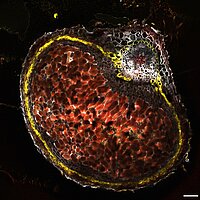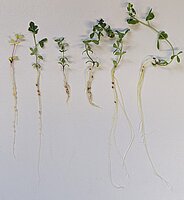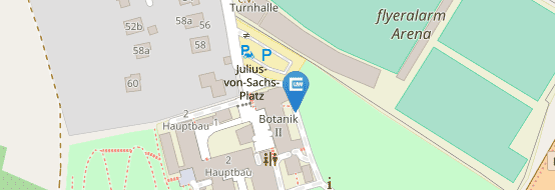Moritz Sexauer
Moritz Sexauer
Julius-von-Sachs-Institut für Biowissenschaften
Lehrstuhl für Botanik II
- Ökophysiologie der Pflanzen -
Julius-von-Sachs-Platz 3
D - 97082 Würzburg
Tel.: +49 (0) 931 31 85065
moritz.sexauer@uni-wuerzburg.de
Raum: OG 106

Research Focus
Root nodulation symbiosis: ensuring a good bargain
How plants balance their diet: genetic control of nitrogen foraging
The role of small RNAs in systemic communication in plant symbiosis and development
Legumes - pioneers and survivors under extreme conditions
Research interests
Nitrogen is probably the most important macronutrient in a plants diet. Although ~80 % of our atmosphere consists of elemental dinitrogen, plants cannot utilize it and rely on nitrogen in form of mostly nitrate, ammonia or other organic compounds. To deal with nitrogen limitation and acquire sufficient amounts of nitrogen plants evolved various strategies. The majority of plants relies on uptake of soil nitrogen via their root system. However, most Legumes and some members of the related Fagales, Curcubitales and Rosales lineages are able to establish symbiotic relations with rhizobial bacteria, respectively Frankia to fix aerial nitrogen.
Both the nitrogen fixing Rhizobia-Legume symbiosis and plants root growth is known to be dependent on the external nitrogen supply and the systemic nitrogen status of the plant.
In my research I’m interested in how legumes adapt their symbiosis according to their demand for nitrogen and its availability. At the same time, I’m looking at the foraging response, the adaptation of roots to available nutrients in the soil, of plants inhabiting different ecological niches.
Comparing the evolutionary young nitrogen fixing symbiosis and the ancestral root developmental programs we hope to gain insight how the nitrogen fixing symbiosis evolved and which steps were crucial in its evolutionary success.
In this context I’m interested in the role of systemic micro RNAs driving the plants adaptations to nutritional and biotic cues. To address these questions, I mainly utilize the model plant Lotus japonicus and its endosymbiont Mesorhizobium loti as a non-symbiotic plant, Arabidopsis thaliana is used for comparison.
Teaching
Bachelor or Master thesis open for application
If you are interested in symbiosis and nitrogen homeostasis and or miRNAs feel free to write me a mail.
Variety of topics available, fields of work can include:
- plant-(eco)physiology
- biotic interactions
- genetics
- plant transformations
- molecular biology: including DNA, RNA and protein methods.
Peer reviewed publications
- Valmas, M.I., Sexauer, M., Markmann, K. and Tsikou, D.(2023) Plants recruit peptides and micro RNAs to regulate nutrient acquisition from soil and symbiosis. Plants 12:187.
PubMed - Sexauer, M., Shen, D., Schön, M., Andersen, T. G., Markmann, K. (2021) Visualizing polymeric components that define distinct root barriers across plant lineages. Development;(doi: 10.1242/dev.199820).
PubMed - Tsikou, D., Yan, Z., Holt, D. B., Abel, N. B., Reid, D. E., Madsen, L., Bhasin, H., Sexauer, M., Stougaard, J. and Markmann, K (2018). Systemic control of legume susceptibility to rhizobial infection by a mobile microRNA. Science 263:233-236.
PubMed










